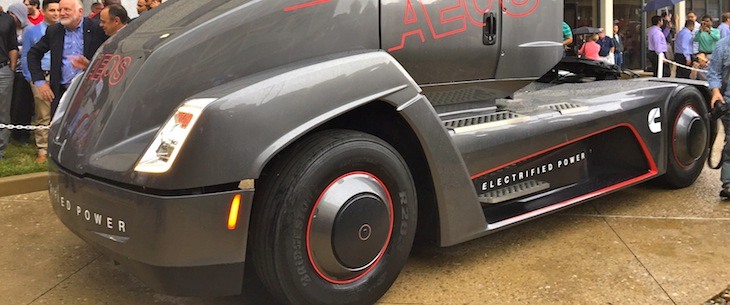Electric trucks gain traction, costs to operate could be 65% less than diesel
by September 20, 2017 4:46 pm 1,201 views

The greenhouse gas emissions requirements and SuperTruck II funding have increased interest in electric powered trucks and tractors, according to a report by ACT Research and Rhein Associates.
The report, North American On-Highway Commercial Vehicle Engine Outlook, explores trends in engine displacements, engine type, captive versus non-captive engines and premium versus non-premium power for Class 8 vehicles.
Several companies recently announced changes impacting the electric vehicle industry. Cummins Inc. recently announced an all-electric Class 7 truck. The company expects to start production of electric powertrains for transit buses throughout the world in 2019, according to Reuters.
“Company executives said that more industrial and commercial uses will follow in the years to come, especially as the battery range for (electric vehicles) increases,” said Tom Rhein, president of Rhein Associates.
The cost of equipment is the “biggest barrier to greater adoption of electric vehicles in local and return-to-base applications,” according to Baudendistel. Battery costs for electric commercial vehicles need to decline about $80 per kilowatt-hour to about $105 per kilowatt-hour “to make the numbers work.”
While Cummins recently announced an all-electric truck with a 100-mile range, Tesla is expected to announce a truck with a range between 200 and 300 miles. The announcement might come in October, said Philippe Houchois, equity analyst for Jefferies.
Based on the proposed range of the Tesla truck, its battery might have a capacity of least 400 kilowatt-hours and cost between $80,000 and $100,000, nearly as much as an existing Class 8 tractor, according to Houchois. The weight of the battery and motor would slightly exceed the mass of a diesel powered powertrain, but “over time, progress in cost and density could take the cost down to $40,000 and the mass down by one-third.”
OPERATIONAL COSTS
The cost to operate the electric truck, however, would be 65% lower than diesel. An existing diesel-powered Class 8 truck receives about 5-6 miles per gallon at a cost of $2.7 per gallon, but the efficiency of an electric truck would be 144 kilowatt hours per 100 miles at an average cost of $0.12 per kilowatt-hour.
“Charging and potentially swapping are separate issues that would materially add to cost, while fast charging multiple 400 (kilowatt-hour) batteries would require mini-grid updates,” Houchois said. “Battery longevity could be the major hurdle given the current trucking business model.”
“When customers buy a ($100,000+) truck they typically pay about 50% of the price over (three+) years, drive (500,000) miles with the confidence that the truck (manufacturer) will guarantee the residual value because that truck has another (500,000) miles of useful life,” according to Houchois. “At ($80,000) and assuming (500,000) miles of usable life, the full cost of an electric truck would be the same per mile as a diesel truck. Assuming battery cost of $100 (per kilowatt-hour), the lifetime cost of an electric truck could be 30% lower than a diesel truck.”
Truck leasing companies “will be reluctant to guarantee the residual value of batteries,” Houchois said.
“We see better potential in applications for medium-duty semi-urban and urban deliveries and for buses, where in both cases vehicles go back to base at the end of the day.”
TRUCKING INDUSTRY TRENDS
Meanwhile, American Trucking Associations’ advanced seasonally adjusted For-Hire Truck Tonnage Index rose 8.2% in August, from the same month in 2016. The index rose 7.1% to 149 in August, from 139.1 in July.
For the first eight months of the year, the index has risen 2.1%, from the same period in 2016.
“Tonnage was stronger than most other economic indicators in August and more than I would have expected,” said Bob Costello, chief economist for the ATA. “However, prep work for the hurricanes and better port volumes likely gave tonnage an added boost during the month.”
“I suspect that short-term service disruptions from when the storms made landfall, as well as the normal ebb and flow of freight, could make September weaker and tonnage will smooth out to more moderate gains, on average,” he said.
Orders of trailers were flat at 15,600 units in August, from the same month in 2016, according to ACT Research.
“The strong order pace we’ve seen throughout this year eased a bit in August,” said Frank Maly, director of commercial vehicle transportation analysis and research for ACT. “Our preliminary information also indicates a weak month for flatbeds. The result is total industry net order volume up versus July, but at a rate that’s actually a bit less than normal seasonal patterns project.”
Through the first eight months of the year, orders of trailers have risen 38% to 169,000 units, from the same period in 2016, showing a positive fleet outlook for the short and medium term. “The uncertainties about implementation and timing of the (greenhouse gas) requirements for trailers could generate some headwinds for orders in the near-term, with a resulting impact on production for early 2018,” Maly said. “It’s a situation we are watching closely.”
The majority of North American orders of Class 8 trucks, or the big rigs that pull the trailers, are expected to be built this year, according to ACT Research. A total of 59% of the orders that were made in August are set to be built this year, and this is in line with historical averages.
